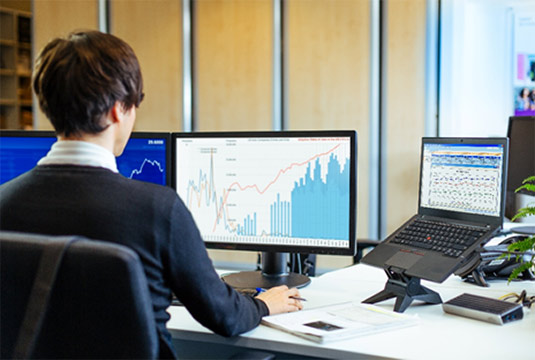1. Give employees a choice
The Steelcase report shows that the most highly engaged employees tend to be those that have the highest degree of control over how and where they work. That doesnt mean we all have to spend this yea's bonus ripping our offices apart and rebuilding them according to our interpretation of a Silicon Valley office (as fun as that could be... Google, Facebook).
But we should try to make the most of our workspace, in a way that's valuable to everyone. A move to hot-desking is a great way to make the most of office space but can be perceived by employees as the company taking away ownership of their desks. Give something back to employees by providing them with a choice of flexible working areas designed to meet different needs: private individual areas, meeting rooms designed for collaboration and breakout areas alongside hot-desks. This is an approach to workspace best known as activity-based working (ABW). Similar to hot-desking, ABW is based on desk sharing in order to maintain lower costs and make better use of office capacity. However, more emphasis is placed on meeting the needs of every employee throughout their working day.
Have a meeting with a focus on creative brainstorming?
No Problem.
Need to take a private call without leaving the office?
Easy.
Need to relax for a moment and take a break away from a screen?
We encourage it!
Remember
Take away desk ownership
Give your employees new and intresting places to work instead
2. The only way to do it right is with the right technology
Beyond a choice of environment organisations need to provide the right technology to enable employees to be productive such as a sufficient internet connection and speed over Wi-Fi, extra screens to work from when necessary and high resolution screens for employees who work with complex editing and design programs.
Despite the mobile revolution the Steelcase report found that the vast majority of workers worldwide still use fixed technology at work with 86% of workers being provided with a landline telephone, and 80% with a desktop computer. Compare that to the 39% of employees who are equipped with a mobile phone or laptop and 14% with a tablet.
That's not to say that new approaches to working require every employee has access to brand new cutting-edge devices. But a flexible approach to desk infrastructure can seriously inhibit productivity if employees don't have access to the right tools to allow them to plug in and work at any desk.
Consider whether your device strategy will need to change as a result of a flexible approach to workspace. Does your company already have a BYOD or CYOD strategy in place?
How do you plan to support that at shared desks?
Targus Universal Docking Stations are a one size fits all solution, allowing employees to sit down at any desk and plug in one cable to their device for connection to the network, extra screens and desk accessories. So they can get straight to work. No time wasted, no strain on IT. Targus Docks are the only Universal Docking solution to offer integrated power, helping your employees to stay charged up when they are in the office and avoid downtime when they're not.
Unique software also ensures that anyone plugged into a Targus Docking Station will automatically be switched to the Ethernet network, decreasing the burden on Wi-Fi bandwidth in that area.
3. Strike a balance
Ultimately a productive office will look different for every business. It depends on the space you have access to as well as the people you employ. Design experts say office design should focus on flexibility, functionality and beauty. We think there's one thing missing from that: Comfort. No employee will be at the top of their game while feeling discomfort, from the chair they sit in, to the amount of visual privacy they have and these issues will be magnified at shared desks.
Try to strike a balance between what everyone needs and will be comfortable with. Provide Privacy Screens for desktop monitor, laptop and tablet screens. Educate employees about the benefits of a good sitting posture and encourage them to take regular breaks from looking at a screen.
At the end of the day hot-desking might look good for your bottom line but you better think twice if you think you're doing your employees a favour at the same time. Make sure the office is still an appealing place to come and work or you might find your employees working from home or not at all!
Tell us about your experiences with hot-desking on Twitter using our handle @Targus_Europe
Visit our Business page: www.targus.com/uk/business











